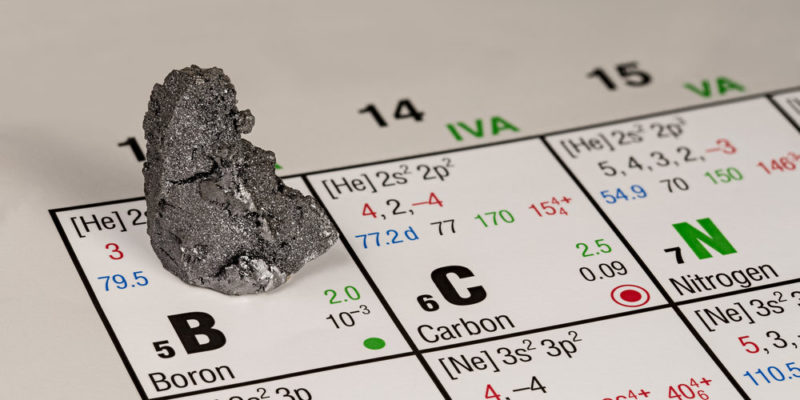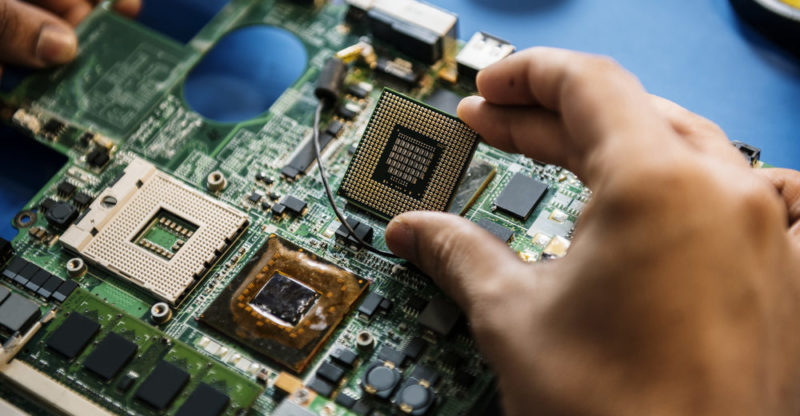We explain what the metalloids are and what their shapes and color are like. Also, what are its characteristics, properties and uses.
What are metalloids?
Metalloids or semimetals are a class of chemical elements that show intermediate behavior between metals and non-metals , in terms of ionization energies and binding properties.
It is not easy to distinguish them from true metals . They conduct electrical current better than non-metals, but they are not good conductors like metals. In addition, they are usually very varied in their shape and coloration .
The list of metalloids includes the following elements:
- Boron (B)
- Silicon (Yes)
- Germanium (Ge)
- Arsenic (As)
- Antimony (Sb)
- Tellurium (Te)
- Polonium (Po)
Characteristics of metalloids

- Location in the Periodic Table . The metalloids are found, within the Periodic Table, on a descending diagonal from boron to polonium, scattered between columns 13, 14, 15 and 16, and dividing the table in two. Elements in the middle to the right are nonmetals , and those to the left are metallic.
- Shape and coloration . The metalloids are very varied in terms of their shape and color. They can be bright or opaque, and many of them have more than one allotropic state, that is, different presentations according to their molecular structure. Arsenic, for example, can be gray, yellow, or black, depending on its allotropic form. Silicon, similarly, can appear as a shiny solid crystal or as a brownish amorphous powder.
- Electric driving . Most metalloids are semiconductors (they can behave as conductors or insulators, and they transmit electricity better in one direction than the other) rather than complete conductors, and in this they differ from metallic elements. However, they are much better conductors than non-metals (insulators), which is why they are often used in the electronics manufacturing industry.
- thermal conduction . Metalloids conduct heat energy much better than non-metallic elements, without reaching the high conductivity of metals. In general, they are not considered good conductors of heat.
- Reactivity . Given their intermediate condition, metalloids react differently depending on whether they are in the presence of a metallic element (so they react as a nonmetal) or a nonmetallic element (so they react as a metal). They have an affinity for various elements, depending on each one, and that is why they are usually found in minerals together with them, such as uranium, lead , sulfur , etc.
- Toxicity . Although some metalloids are essential for the formation of vital molecules (for example arsenic, which is found in the body of living beings ), it is possible that they represent a danger to health. Boron poisoning or arsenic itself (highly toxic) can be lethal; and for its part, polonium is a toxic and highly radioactive element, that is, it emits alpha particles that are harmful to health, being potentially carcinogenic, immunosuppressive and mutagenic.
States of aggregation of metalloids

Most metalloids usually appear solid at room temperature , either as crystals (such as arsenic) or as brittle, opaque blocks (such as germanium).
However, some have curious properties in terms of phase change. For example, arsenic goes directly from a solid to a gas (sublimation) in the presence of heat (and at normal atmospheric pressures).
Atomic Properties of Metalloids

The metalloids are very diverse in their atomic characterization. There are some with a high atomic weight, such as polonium (209 u) or antimony (121.76 u), and others that are rather light, such as boron (10.81 u) and silicon (28.08 u).
The same happens with their densities, which range from 2.37 g/cm 3 (boron) to 9.32 g/cm 3 (polonium) and with their electronic configuration, which can have a different number of electrons in the last layer. : 3 (boron), 4 (silicon, germanium), 5 (arsenic, antimony), and 6 (tellurium, polonium).
Abundance of metalloids
Some metalloids are extremely abundant in the earth's crust , such as silicon, which forms numerous compounds called silicates, or arsenic.
Boron, for its part, exists abundantly, but as part of the mineral called borax, since it does not exist in a free and pure state in nature.
Polonium, on the other hand, is quite rare and appears only as part of certain uranium ores; and antimony is found in very small percentages in the earth's crust.
Uses of metalloids

Most of the semi-metals are used for the manufacture of electronic devices and semiconductor elements, such as rectifiers, transistors, diodes, integrated circuits or even (as in the case of silicon), chips and microprocessors . However, their variety qualifies them for many different uses.
For example, some isotopes of boron are useful in the absorption of neutrons within nuclear power plants, and function as mechanisms for regulating atomic reactions.
The above content published at Collaborative Research Group is for informational and educational purposes only and has been developed by referring to reliable sources and recommendations from technology experts. We do not have any contact with official entities nor do we intend to replace the information that they emit.
MA student of the TransAtlantic Masters program at UNC-Chapel Hill. Political Science with a focus on European Studies. Expressed ideas are open to revision. He not only covers Technical articles but also has skills in the fields of SEO, graphics, web development and coding. .
Leave a reply
Your email address will not be published. Required fields are marked *Recent post

Sport: What Is It, Types, Risks, Features, Characteristics and Examples

Dogs: Emergence, Features, Characteristics, Feeding and Breeds

Story: Definition, Elements, Structure, Features and Characteristics

